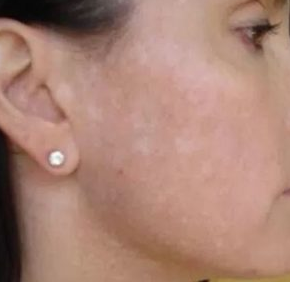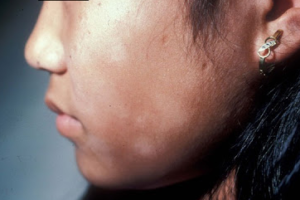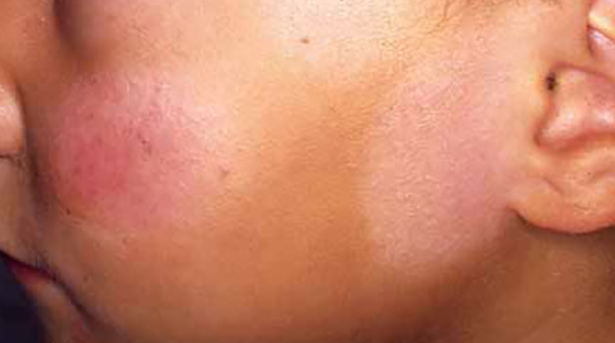What are these patches on face? Generally, white patches or spots on skin including the face aren’t really cause for concern. However, it could mean there is an underlying problem such as fungus infection, allergies, vitiligo, vitamin deficiency or even an autoimmune disorder. Could it be cancer of the skin?
Find out more as we explore the causes, symptoms and treatment to get rid. The page will also provide pictures to give visual aid on each underlying cause and symptoms.
Having white patches on skin including the face could mean there’s an underlying health problem. It could be vitiligo. This is a medical condition that causes white patches on the skin. It could appear anywhere but mostly on the face, hands, back and other body parts.
White spots or patches can also appear on inside tissues of the mouth, the nose as well as the retina. Having white spots on your face could also be a signal of skin cancer. However, there are a number of underlying causes that can lead to white patches on the skin. We will discuss more under the causes.
Pictures, Images of white patches on face
Pictures and images inserted in the post are to give you a visual aid on how these white spots or patches on the skin look like. Below, see a picture of the appearance of white patches on the face.


White patches on face causes
There are several reasons for having white patches or spots on face. Having understanding of these underlying causes is important in finding the appropriate treatment. Generally, having a white patch on skin particularly the face shouldn’t be a cause for concern. Skin discoloration can be influenced by a number of causes including: eczema, yeast infection, skin conditions among others. Below is a discussion of each cause.
1. White patches due to fungal infection – Tinea Versicolor
The spots or white patches on your face may as well be yeast infection affecting the skin, particularly tinea versicolor. This is a fungal infection of the skin. Also known as the pityriasis versicolor, it is caused by a yeast infection that naturally lives on the skin.
Rarely does the yeast infection cause any health problem. However, the yeast can sometimes grow out of control affecting the natural color, appearance or the pigmentation of your skin. If this happens, you may develop patches of white patches or rash on the skin including the face. The infection tend to happen under the following reasons:
- Having oily skin
- If you sweat a lot
- Having a weak or compromised immune system
- Living in a hot climate
- Hormonal changes
The most visible symptoms of tinea versicolor is the appearance of discolored white spots or patches on the skin. These patches may be lighter or darker than the surrounding skin. The patches are times dry, scaly and itchy.
How is tinea versicolor treated? If the symptoms are mild, you may treat your condition at home. You can use over-the-counter antifungal creams or shampoos to kill the infection. Here are some of the OTC medications to treat your condition. They include:
- Selenium sulfide
- Terbinafine
- Miconazole
- Clotrimazole
2. Vitiligo
White spots or patches on your face may as well be vitiligo. This is a long-term skin condition that is characterized by pale, white patches on the skin due to lack of chemical component called melanin. It can affect any area of the skin. But most likely affected area include the face, neck and hands. These are parts directly exposed to the sun. The condition varies from one person to person. Some people are likely to get few small patches while others can suffer large areas of their skin.
Although the exact cause of vitiligo hasn’t been established, certain things can increase the risk of developing vitiligo. They include:
- Compromised immune system-overactive thyroid gland
- Autoimmune disorders
- Family history
Vitiligo is not an infectious disorder, therefore it cannot be spread. The white patches from vitiligo are usually permanent. If the patches are quite small, creams can be used to cover them. Treatment such as phototherapy and a combination of medication can give you the best results.
3. Pityriasis Alba
This is a skin problem that commonly affects young adults and children. The exact cause for this condition is not known. However, the disorder is linked with eczema, another common skin disorder that is characterized by scaly, itchy rashes.
The noticeable symptoms are appearance of red or pink round or oval patches. With application of moisturizing creams the patches normally clear up leaving pale white scaly and dry patches on the face.
No treatment is required for this condition. The patches usually resolve on their own with time. However, your doctor may prescribe moisturizing or topical steroid cream such as hydrocortisone to cure the condition. The creams are useful to cure skin discoloration, relieve itchiness, scaling and dryness.
4. Vitamin deficiency
Lack of certain vitamins can causes development of white patches on face and skin. The deficiency of vitamin B12 can also cause neurological problems and anemia. It is advisable you visit your healthcare provider as soon as you notice white spots or patches on your face. Regular intake of Vitamin B can help eliminate problems like indigestion and reducing the appearance of white patches on your face.
5. Sun exposure and tanning
Does exposure to sunlight or tanning cause white patches on face? Tanning is basically darkening of skin resulting from exposure ultraviolet rays from sunlight from artificial sources. Moderate exposure to sunlight is beneficial to production of melanin and Vitamin D. white patches from tanning or sunbath are harmless. However, if you excessively expose your skin to too much sunlight, you risk sunburn and cancer of the skin.
The appearance of white spots on face caused by tanning can be minimized by applying a quality tanning lotion before going for sunbath or tanning in the bed.
6. Hypopigmentation
Having white spots and patches on your skin can as well be due to hypopigmentation. The cause is due to melanocyte or depletion of melanin. This can due to a decrease in the amino acid tyrosine responsible for melanin production by melanocytes.
This condition can be classified into two broad category. They include:
Generalized hypopigmentation – this is reduction of melanin or pigmentation at birth, congenital.
Localized hypopigmentation: can be due to partial or complete loss of melanin.
Single or white patches can be observed. In both cases, the main diagnosis and treatment include laser treatment.
7. Hormonal changes
Changes in hormones especially during pregnancy can cause the color of the skin to change. This can be due to increased level of hormones in females. The changes on the skin can be anywhere including your face. The changes can cause dark or white patches on the face.
8. Birthmarks
The other possible cause of white spots or patches on the skin can be due to genetics. These white patches are usually present at birth. Moles which aren’t cause for concern only if they change in size of shape, are usually brown or black but can change in color to white.
9. Skin cancer
Patches on the skin can be due to skin cancer. Cancer of the skin can occur when genetic material in the skin gets destroyed, this can be due to excessive exposure to the sun or chemicals. This damage causes the cells of the skin to grow out of control and form a mass of cancerous cells.
10. Lichen Sclerosis
This is a long-term skin condition affecting mainly the genitals and anal areas. It is characterized by itching and white patches that appears on the affected skin. Other areas to be affected by this skin condition include the face, arms, back, breast and shoulders.
Although the exact cause of this condition is not known, it can be associated with over activity of the immune system. The condition is more common in women who have gone through menopause. Men and children are also likely to be affected. The condition is not infectious and therefore cannot be spread to other people.
Treatment for lichen sclerosis is steroid ointment or cream which should be applied regularly to help control symptoms. In addition to above treatments, self –care measures can help. They include:
- Avoid washing the affected area of the skin with soap or bubble bath. This means you should use plain water or emollient.
- You should avoid rubbing or scratching the area
- You should apply barrier cream or ointment
White slightly raised patches on face
White slightly raised patches or spots on your face could be as a result of birthmarks. They are usually present at birth. They can be flat or slightly raised from the skin. Birthmarks can appear in different colors ranging from red, black, tan, pink or white. They are harmless and really not cause for concern.
Dry white scaly patches on face
What are these dry scaly white patches on your face? Having flaky patches on face could mean an underlying skin disorder such as eczema, acne, vitiligo, psoriasis, hives among others. These skin conditions vary greatly in symptoms and severity. Some can be temporary while others are permanent painful or painless. Having a skin condition on your face can be minor or life threatening.
There is no really cause for concern. Most of these skin condition causing flaky dry white patches on face are treatable. Treatments include:
- Laser therapy
- Antibiotics
- Vitamin or steroid injections
- Medicated creams and ointments
- Antihistamines
You can regularly treat dry white patches on your face with:
- Over-the-counter skin care products
- Dietary changes
- Medicated makeup
- Good facial hygiene
Skin conditions may require the attention of a doctor. Do not hesitate to visit your dermatologist for medical advice and checkups.
Itchy white patches on face under eyes
Itchy white patches on your face under the eye can be uncomfortable and sometimes a difficult condition to live with. Itchiness or a burning feeling can be caused by a number of skin conditions. The possible causes for itchy patches on the face include eczema, fungal infections or pityriasis Alba among other. If you have itchy patches on the face, consult your dermatologist, he will prescribe antifungal creams to relieve your symptoms.
Treatment, heal, cure for white patches on face
What are the available treatment for white patches or spots on face? Treatment or cure is entirely dependent on the underlying cause of your symptoms. If your healthcare provider finds the particular condition, he will attempt to cure the condition causing white patches on your face. The skin discoloration may be resolved with either medical treatments or home remedies. Here are some of the medical treatments. They include:
- Antifungal creams and lotions like miconazole and clotrimazole can be useful in treating tinea versicolor
- Vitiligo has no treatment. However, treatment such as phototherapy and a combination of medication can give you the best results.
- Chemical peels particularly that has salicylic acid and glycolic acid can be used to remove the outer layer of the skin that is discolored
- Laser therapy
- Skin grafting and depigmentation are also known as effective treatment.
How to get rid of white patches on face naturally- Home remedies
White patches on the skin are usually boring and give unpleasant look. Your self-esteem and confidence is greatly affected. However, other than medical treatment, we have home remedies to help you get rid of these white spots or patches on your face. Here are few home remedies to naturally help you.
1. Coconut Oil
Coconut is effective in eliminating white spots on skin. It can help to get rid of fungal infection, inflammation and reduce itching caused by these white patches on face. Applying two to three times in a day for a couple of weeks can improve the appearance of skin.
2. Ginger juice
This juice is another effective home remedy for clearing white spots and patches on your face. It helps increase blood circulation which can help cure vitiligo. Put freshly prepared ginger juice on the affected area on the skin. Allow it to dry then rinse with warm water. Alternatively, you can drink the juice of ginger roots for a couple of days.
3. Babchi
Also known as psoralea corylifolia, babchi plant has significant medicinal value. This plant has properties that are antifungal, aromatic and antibacterial that can be applied on the skin to help get rid of skin problems and reduce hypopigmentation effectively at home. Vitiligo and psoriasis are some of the skin conditions to be treated by babchi.
The powder derived from the seeds can be applied topically on the skin to get rid of the patches. At times, you could use the seeds to make babchi oil to apply on your face affected with white patches.
4. Cabbage Juice
Try cabbage juice to get rid of white patches on skin. Extract of fresh cabbage juice can be applied topically on the affected skin on your face. Leave the juice on the face with white patches for about 10 minutes and then rinse off with warm water. This can help get rid of the white spots or patches on your face.
5. Vitamin B
One of the cause of white patches on the face is lack of Vitamin B. include Intake of vitamin B in your diet to stop problems of indigestion and eliminate white patches on the skin.
6. Reduce Exposure to Sun
Excessive exposure to sun and tanning is one of the cause of white patches or spots on your face. This can lead to skin damage and risk of skin cancer. It is important to reduce skin exposure to sunlight to minimize the risk of white spots or patches on your face.
7. Sunscreens
Sunscreen helps to prevent skin damage and white spots on the skin and face. Look for quality sunscreen to reduce patches on the skin.
Sources and references
- http://www.webmd.com/skin-problems-and-treatments/tinea-versicolor-cause-symptoms-treatments – 1
- http://www.healthline.com/health/tinea-versicolor – Overview1
- http://www.nhs.uk/Conditions/Vitiligo/Pages/Introduction.aspx
- http://www.healthline.com/health/pityriasis-alba – Overview1
- http://www.drgreene.com/qa-articles/white-patches-skin/



